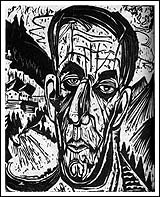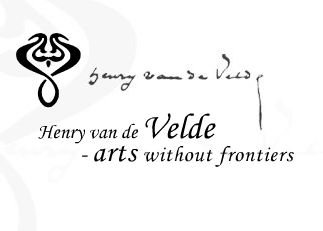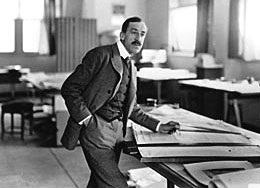The founders of this organisation included, in addition to van de Velde and Muthesius, Peter Behrens, Jozef Hoffman, Jozef Olbrich and Richard Riemerschmid. In the founding manifesto it was stated that: "there are no fixed borders between a tool and a machine. Quality products can be produced either with the aid of a tool or a machine, provided that people use the machine as a tool." The Werkbund also planned to incorporate the creativity of the artist in industrial manufacture, whereby the end-product would have both "a content of sensitivity and an artistic implication."
Muthesius, without doubt the most stimulating force behind the Werkbund, had allready, in 1907, proposed that Peter Behrens should work as an artist for AEG in Berlin. Henry van de Velde did not want to sacrifice his artistic freedom to the demands of industry.
Similarly, he seemed to be still attached to the traditional arts and crafts. However he had also himself at times worked in the service of industry: for the porcelain manufactures of Meissen, Jena and Copenhagen he had designed services where he had clearly conformed to the laws and norms of mass production. The different insights of Muthesius and van de Velde were bound to lead to a polemic, which was expressed in Cologne in 1914. Muthesius defended the case of standarisation, whereby the artist contained a universal relevance giving rise to generally accepted criteria of taste. Van de Velde, supported by Obrist, Endell and Bruno Taut, responded with an uncompromising: "As long as there are artists in the Werkbund they will oppose any proposal for a norm of standardisation. The artist is in his heart of hearts an ardent individualist, a free and spontaneous spirit. He will never voluntarily subject himself to a discipline wich impose on him normes and types".
The succes of the Werkbund theatre was however to be short-lived: in August 1914 the first World War broke out and the exhibition centre was used as barracks. In the meantime van de Velde had already given notice of his departure to the Grand Duke of Weimar, weary of the intreagues of the neo-Biedermeier court and the associated conservative artistic circles. His friend Kessler had already fallen victim to these circles and had lost his post as director of the Weimar Museum trough presenting "scandalous" drawing of nudes at the Rhodin exhibition. The outbreak of war prevented van de Velde from leaving Weimar (as a foreign he had even had to report to the police three times a week) and doomed him to a period of artistic inactivity. In 1917 he was finaly able to leave for Switzerland, where he had numerous contacts with artists and intellectuals in Bern and Zurich (incluiding Kirchner, Masereel Romain Rolland). He was only to resume his artistic activity when the Kröller-Müller couple (who ran a shipping company) asked him to work for them in 1920 in the Netherlands. He built a house for himself in Wassenaar near the Hague (1921): an impressive prefabricated wooden construction, erected by the company Christoph and Unmack from Niesky (Silesia). He replaced the Dutch architect H.P. Berlage.
In addition to a number of minor works van de Velde was principally busy with plans for the Kröller-Müller Museum. The task was far from simple: to errect a building in a beautifull nature park (De Hoge Veluwe) to house the Kröller-Müller collections (paintings, statues, porcelain). The plans which van de Velde produced between 1921 and 1926 could not however be realised owing to the financial difficulties experienced by the Kröller-Müller shipping company.
| |
 |
| |
Portrait of Henry van de Velde
by E.L. Kirchner |
The project was however realised at a later date in a simpler form (the first part in 1937, with an extension in 1953). Despite the great sobriety of the architecture, this museum stands today as one of the best examples of pre-war Museum architecture. Van de Velde created attractive rooms, one merging into the next, wich, thanks to a sensitivity choice of natural lighting, looked out upon the surrounding natural beauty. In 1925 van de Velde returned to Belgium, at the invitation of King Albert and Camille Huysmans, the Minister of Art and sciences. His first task was to set up the Institute of Decorative Arts at the former Abbay de la Cambre in Brussels. Until 1935 he remained as the director of the school, where he was able to relive his experiences from the Weimar Kunstgewerbeschule. In addition to building yet an other new house for himself, ("La nouvelle maison" at Tervuren, just outside Brussels) and a number of commissions from private individuals, he worked principally for the Goverment: as artistic advisor Belgium Railways and for the Navy as chairman of the artistic commitees of the Belgian pavillons at the World exhibitions of Paris (1937) and New York (1939). But his major work from this second Belgian period is without doubt the building of the university library of Ghent (from 1936). In the large book towers and reading rooms and offices of the library van de Velde achieved a truly exceptional purity of form. The rational, a constant feature of his work, excludes all ornamentation: a purity of line and corners binds the building in a strictly rational whole.
Just at the first World War marked the end of his Weimar period, so the Second World War once more put an end to his artistic production. This time for good. He left Belgium in 1947 and set up home in Oberagerij, Switzerland. He did not build his final home himself: he moved into a house built by the architect Alfred Roth in 1939. It was there that he wrote his "memoires" and in 1957, at the age of 94, died in a Zurich hospital. His journey through Europe was over. Despite a succession of hostile and contradictory circumstances van de Velde had nevertheless relentlessly pursued what he himself referred to as "the holy way" in order to achieve his goal: by strength of soul and intellect, to overcome imitations of style by offering genuinely new creations. In this respect the message of Henry van de Velde is still of significance to us all today.



